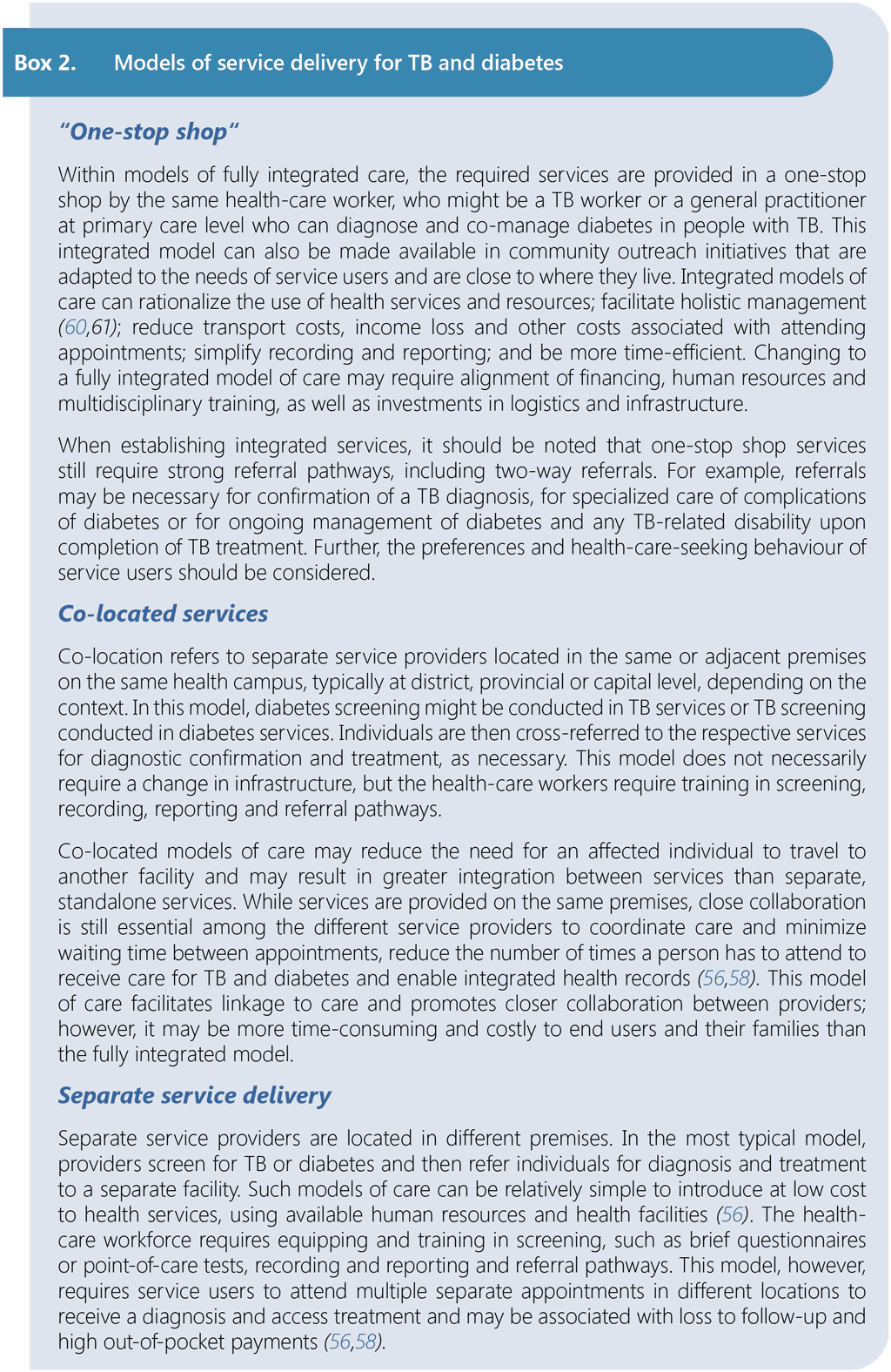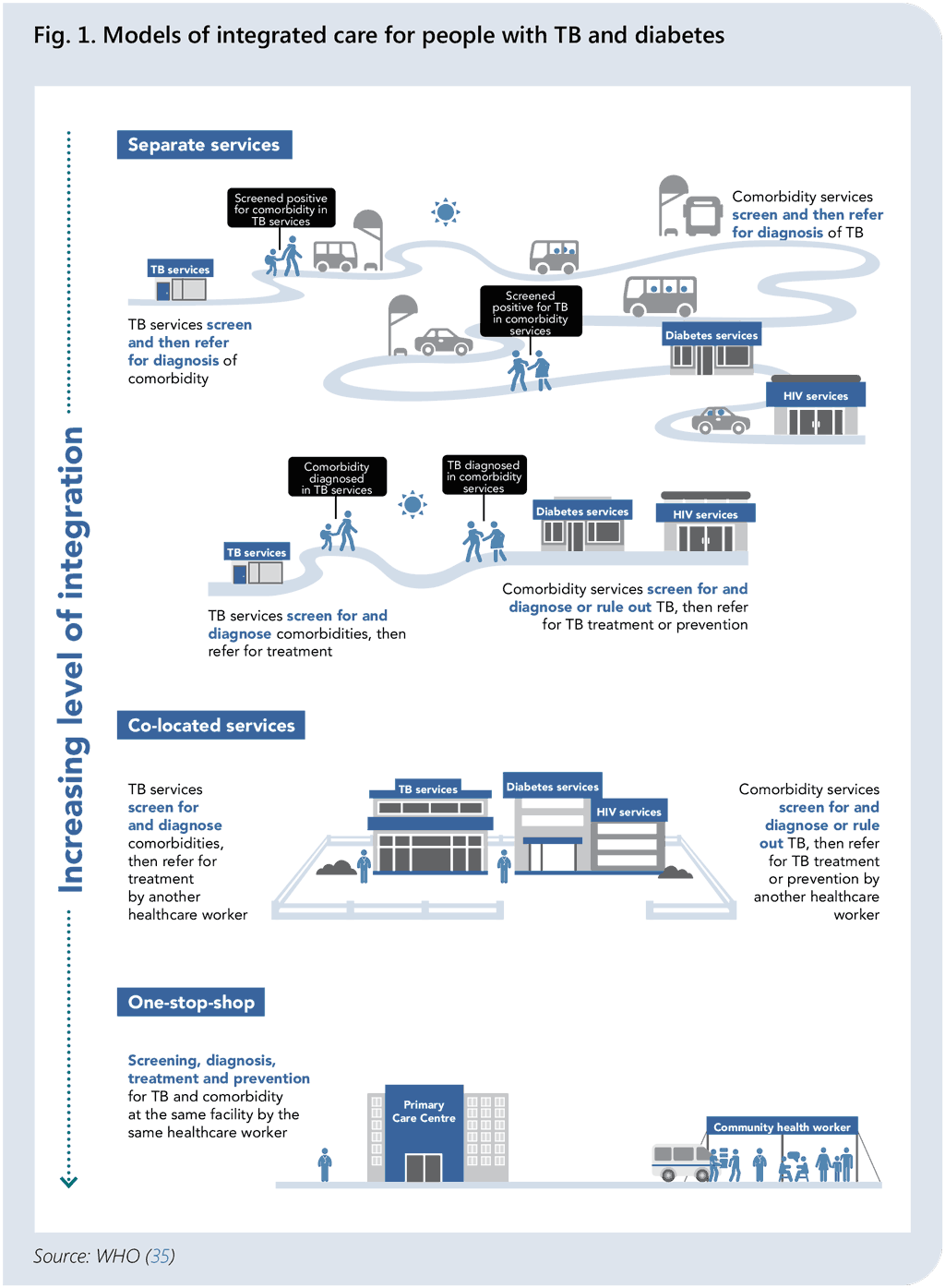Enlaces transversales de Book para 1266

2.3.1 Identify priority comorbidities and interventions.
During programme planning, priority interventions should be identified to scale up and strengthen collaboration on TB and diabetes. Gap and root cause analyses should be used, which may also cover other comorbidities and common risk factors for TB and diabetes, such as smoking, alcohol use and cardiovascular disease. Criteria for prioritization and placement of services and interventions should be established in consultation with the coordination platform or related technical working group(s). These criteria may include the burden of morbidity and mortality, cost implications, ethics, equity and human rights considerations and acceptability. Some of the tools that can be used for prioritization and optimization of interventions include the People-centred framework for TB programme planning and prioritization (52) and modelling such as impact modelling or modelling for cost-effectiveness). Further details are outlined in WHO’s Guidance for national strategic planning for tuberculosis (39).
Collaborative activities for TB and diabetes can be introduced in an incremental manner, based on lessons learnt during scaling up. When implementation of collaborative TB/DM activities is at an early stage, programmes may, for example, decide initially to prioritize diabetes screening and counselling among people attending TB care in urban centres where diabetes services are more easily available. Diabetes screening and counselling can then be rolled out in step with decentralization of the NCD services to primary care. In settings with a high burden of TB, TB screening among people attending diabetes care may also be an immediate priority.
2.3.2 Define and reorient models of care for TB and diabetes and other comorbidities towards people-centred services, primary health care and universal health coverage.
Evidence from observational studies suggests that integrated care for TB and diabetes is feasible and that it can increase screening coverage and improve outcomes for TB (increase cure rates and reduce loss to follow-up), as well as improve the management of diabetes (53–56). Programmes should aspire to decentralize and integrate services for TB and diabetes within primary care to community level, so that people with TB and diabetes can access care on an ambulatory basis (35). In many settings, primary care is an untapped opportunity for decentralization and delivery of integrated services for TB and diabetes. People with TB and comorbidities incur extra costs and time visiting various health facilities and tend to prefer receiving care from fewer providers (57). Models of care should be jointly developed by the TB and NCD programmes, depending on local epidemiology, resources, infrastructure and severity of disease, among others (see Box 2 and Fig. 1).
To mitigate concern about the risk of nosocomial spread of TB posed by integrated service delivery, appropriate airborne infection prevention and control (IPC) measures (see Chapter 3) should be institutionalized in all health facilities, particularly in high TB burden settings. Integrated care may also contribute to reducing transmission of TB through early detection and treatment of infectious TB.
Models of service delivery for TB and comorbidities, including for diabetes, range from those that are most integrated, where services along the cascade of care for TB and diabetes are provided in a “one-stop-shop” by one health-care worker, to the least integrated, where stand-alone diseasespecific providers refer patients to the relevant specialist services (56,58). The extent of integration of TB and diabetes services at different levels of the health system depends mainly on the degree of decentralization of the respective services to peripheral level, the capacity of service providers to co-manage TB and diabetes and access to point-of-care diagnostics and essential medicines (59). In some situations, for example in the case of worsening glycaemic control or of complications, referral to a higher level of care will be necessary. Referral criteria as outlined in the WHO guidance, Diagnosis and management of type 2 diabetes (HEARTS-D), can be found in Annex 3.
In some settings, TB services may be decentralized to primary care level in the community, while the required services for diabetes may be available only at district level. In this situation, where there is no capacity to co-manage TB and diabetes, the separate health-care providers should refer affected individuals and coordinate care according to established pathways. All models of care can be strengthened by engagement of community health-care workers, outreach teams and peer supporters. The models of care described here are categorized according to where a person first seeks care and according to the extent of integration (Fig. 1). National programmes should define the mix of models that best enables the provision of quality-assured, comprehensive services as close as possible to the end user and according to the country context.


2.3.3 Conduct collaborative planning and budgeting to scale up people-centred services for TB and diabetes.
Collaborative planning and budgeting are required to support the introduction and scaling-up of collaborative TB/DM activities at different levels of the health-care system. This should be based on an analysis of the joint burden of TB and diabetes and the access to the necessary health-care services. Joint planning and budgeting for integrated services may contribute to efficiency of resource use and to improved health outcomes. To ensure sustainability, planning should be harmonized with the country’s national health strategic plans, health system-strengthening agenda and overall work towards achieving universal health coverage (UHC) and social protection. The joint plan should be reflected within the strategic plans for NCDs, including for diabetes, and for TB.
Key elements to be considered in planning:
- sufficient time and resources for coordination and engagement of stakeholders, including affected communities and civil society;
- development and updating of guidelines and related standard operating procedures (SOPs);
- equitable, sustainable access to essential tools, medicines and products for screening, diagnosis and management of diabetes, such as weighing scales, blood glucose strips, glucose meters and medicines;
- pre-service and in-service training and measures to ensure an adequately trained, motivated, well-performing health workforce, including social workers and community health workers;
- joint advocacy and communication for the needs of affected individuals and communities for clinical care and prevention of both diseases;
- setting up and maintenance of well-functioning, interoperable health information systems and extension of telemedicine, mHealth and other innovations to bridge service delivery gaps; and
- research, especially operational research, on country-specific issues to develop evidence for efficient, effective implementation of collaborative activities.
2.3.4 Align advocacy and communication across health programmes.
Advocacy to influence policy and sustain political commitment, programme implementation and resource mobilization is necessary to accelerate the implementation of collaborative activities for TB and diabetes. In collaboration with other relevant health programmes and stakeholders, the national TB programme (NTP) and NCD programme should develop strategies for advocacy and communication informed by evidence and local gaps and needs, and advocate for collaborative action on TB, diabetes and other comorbidities at all levels.

 Reacción
Reacción